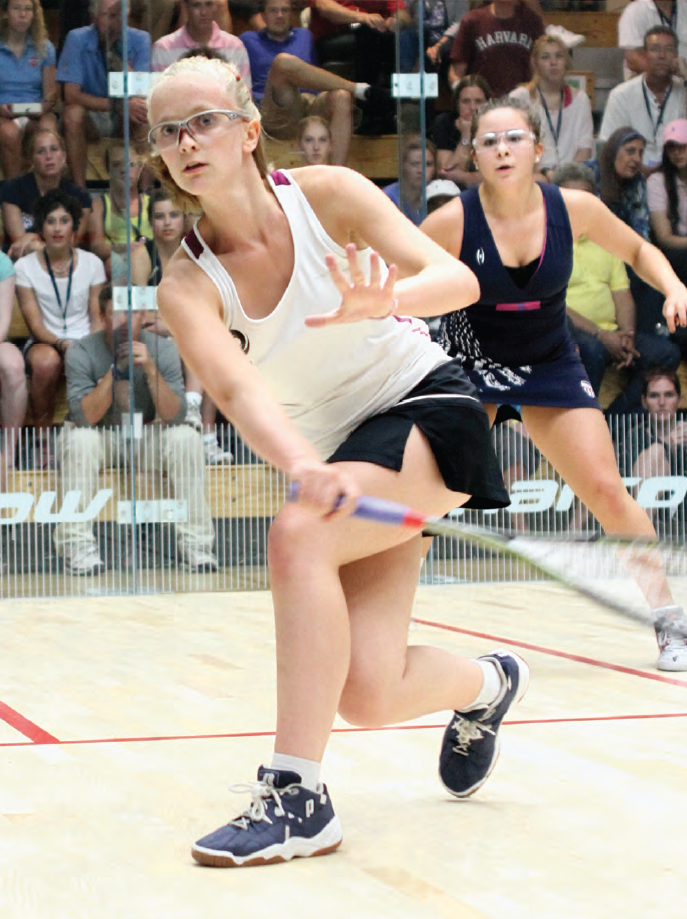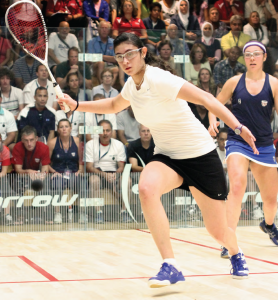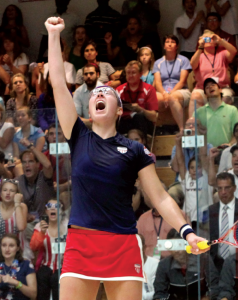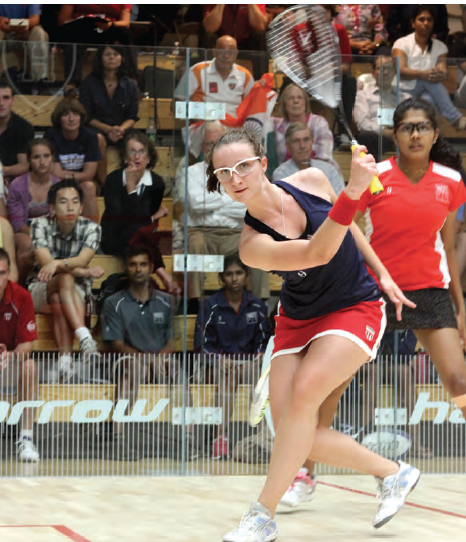

By James Zug
It is a sign of rude and robust health that the lingering feeling about the 2011 Women’s World Juniors Squash Championships was one of disappointment. On the surface, the tournament went off without a hitch, and the United States did beautifully. In the individual event, we had three Americans make the Sweet 16, two in the quarters and one in the semis. Result: best ever. In the teams, the U.S. made the finals and then pushed their opponents to a winner-take-all rubber match. Again, the best finish ever for an American team, men or women, boys or girls.
What ifs, nonetheless, floated through the humid, scorched air in Allston, Mass. Expectations were unnaturally high for the Americans coming into the fortnight. We had the defending champion, Amanda Sobhy, albeit seeded second. We had a second star in Olivia Blatchford, who like Sobhy, was ranked in the top 40 in the world.
Compare this with the only other two times the U.S. has hosted a world championship. In the 1998 world men’s juniors at Princeton, only four boys—out of seventeen Americans—managed to win a match in the individual event (Eric Pearson, Peter Kelly, Rich Repetto and Peter Karlen) and none won more than one match. A typical result was Dylan Patterson, an excellent American player, who lost to future world No. 1 Nick Matthew— 1, 0, 0. At the 1999 women’s world open in Seattle, only two Americans made it into the main draw, and both, the Khan sisters Shabana and Latasha, went out immediately.
This time, the American squad did exceedingly well. In the individual tournament, Haley Mendez, the Heights Casino prodigy, exploded into the international scene by beating Australian Tamika Saxby (11-8, 12-10, 11-9) to reach the round of 16. Another positive result came from Olivia Fiechter, the Philadelphian. After succumbing in her first main-draw match to the Asian junior champion, Anaka Alankamony, in a long (41 minutes) and tight four-gamer, Fiechter snagged three straight wins in the plate competition before losing in the finals.

Blatchford, seeded to make the semis, lost in the quarters to the Englishwoman Emily Whitlock in three games. Whitlock is pretty good: she’s the daughter of Phil Whitlock who reached 15 in the world, and she recently won the European junior title. Sobhy also lost before her seeding predicted she would. Nour El Sherbini, the former world junior champion (2009 at just 13-years-old), beat her 11-5, 12-10, 11-9 in the semis. Sobhy overhit and kept the ball too straight, not twisting the tall and powerful El Sherbini enough. It was a devastating loss for the defending champion.
Nour El Tayeb then took out El Sherbini in a tactically brilliant, fourgame final. El Tayeb had reached the world juniors final the previous two years and lost both times. A third consecutive loss might have ruined her career, if you didn’t know her. She is an ebullient, witty, confident and popular young woman (the Australian team carried her off the court after the medal ceremony). She is well-educated (her father is an nephrologist and her mother is an anesthesiologist and she’s starting university in September) and well-spoken. She also has pedigree. Her father was a national junior champion—he and Khaled Sobhy grew up together and now, three decades later, they both are fathers to world junior champions. She wields her 115g Head Cynano with incredible flair and shotmaking ability. El Tayeb is Amr Shabana in a skirt, the Princess of Cairo, and could easily be in the top ten in a year’s time.
In the teams, it was almost a foregone conclusion that Sobhy would secure a measure of revenge against the Egyptians. It was not easy for Sobhy at the worlds this summer. She was on the cover of this magazine, continuing the legend of a squash version of the SI Jinx (although it was pointed out that the cover subject of the magazine before the world men’s juniors in 1998 did go on to win the tournament). The Egyptian-American was playing in front of a home crowd on her future home courts (she would matriculate at Harvard a few weeks after the tournament), rather than far away in India or Germany like the previous two championships. The pressure certainly was a factor in her loss to El Sherbini. The day the US started its team campaign, I was talking with Sobhy. “Of course, you’re going to come back and beat El Tayeb,” I said, “just like in India in 09.” She smiled and nodded, not saying anything, not wanting to jinx it, but her confidence was back and she clearly wasn’t going to panic a second time. In 2009 team competition, Sobhy had beaten the newly-crowned world champion (El Sherbini) after a disappointing loss in the individuals. It seemed obvious she’d do it again.
But the US team had to first reach the finals. In the semis, they barely defeated a determined India squad. Sobhy won at No. 1, but Blatchford lost to Saumya Karki in three close games. So it was up to Mendez. In a dramatic nail-biter, she beat Aparajitha Balamurukan 11-8, 4-11, 11- 9, 11-9. It was a historic win. For the first time in history, a US team would be in the finals of a world team championship.

Egypt, with much greater depth, surely looked to run away with the title. Coaches Natalie Grainger and Jack Wyant put Sabrina Sobhy rather than Mendez, in at No. 3, hoping that the 14-yearold’s shotmaking variety might match up well. She lost in three, but her older sister Amanda, playing in her final junior event, did beat El Tayeb in four. It took three match balls in the fourth to clinch the match but there never seemed to be much doubt.
So the dual match was 1-1 and Egypt suddenly looked rattled. It came down to Blatchford v. El Sherbini. Unfortunately, El Sherbini proved to be unstoppable in three games, even though Blatchford put some pressure on, especially in the first game.
Everything ran very smoothly at Harvard’s Murr Center. The courts were in good shape. Mike Way changed the lighting and put in a new floor for the all-glass court. The finals started three minutes early and the hourly bus shuttle to the hotel developed the habit of leaving one minute early. The bus was a yellow school bus, which greatly fascinated the overseas players and daily some were posing for photographs in front of it. The girls also enjoyed the freedom of leaving the squash facility, walking across the Charles River and in a few steps being able to mingle in Cambridge’s bustling Harvard Square. The closing ceremonies were held on a cruise ship in Boston Harbor, with a DJ; it was a prom theme, according to tournament director Chris Smith. Record heat (it topped 100 degrees a couple of afternoons) made a boat cruise sound pretty welcomed. Smith also arranged for free laundry service and wifi for the players at the hotel.
Tom Poor crisply managed a team of 73 volunteers from Massachusetts Squash. They did more than just usher. Someone met every one of the 18 other teams when they flew into Logan Airport and personally welcomed them and guided them to their hotel. But the galleries, unfortunately, were not thronged with spectators—being in mid-summer surely didn’t help—and the media attention was sadly not as engulfing as hoped.
Coming in second ain’t what it used to be.





